

POST-COVID-19 ECONOMIC ASPECTS OF DIGITAL TRANSFORMATION ISSUE 2 / APRIL - JUNE 2022
The Economic Commission for Latin America and the Caribbean (ECLAC) is one of five regional commissions of the United Nations Economic and Social Council (ECOSOC). It was established in 1948 to support Latin American governments in the economic and social development of that region. Subsequently, in 1966, the Commission (ECLA, at that time) established the subregional headquarters for the Caribbean in Port of Spain to serve all countries of the insular Caribbean, as well as Belize, Guyana and Suriname, making it the largest United Nations body in the subregion.
At its sixteenth session in 1975, the Commission agreed to create the Caribbean Development and Cooperation Committee (CDCC) as a permanent subsidiary body, which would function within the ECLA structure to promote development cooperation among Caribbean countries. Secretariat services to the CDCC would be provided by the subregional headquarters for the Caribbean. Nine years later, the Commission’s widened role was officially acknowledged when the Economic Commission for Latin America (ECLA) modified its title to the Economic Commission for Latin America and the Caribbean (ECLAC).
Key Areas of Activity
The ECLAC subregional headquarters for the Caribbean (ECLAC/CDCC secretariat) functions as a subregional think-tank and facilitates increased contact and cooperation among its membership. Complementing the ECLAC/CDCC work programme framework, are the broader directives issued by the United Nations General Assembly when in session, which constitute the Organisation’s mandate. At present, the overarching articulation of this mandate is the United Nations Sustainable Development Goals.
Towards meeting these objectives, the Secretariat conducts research; provides technical advice to governments upon request; organizes intergovernmental and expert group meetings; helps to formulate and articulate a regional perspective within global forums; and introduces global concerns at the regional and subregional levels.
Areas of specialization include trade, statistics, social development, science and technology, and sustainable development, while actual operational activities extend to economic and development planning, demography, economic surveys, assessment of the socio-economic impacts of natural disasters, climate change, data collection and analysis, training, and assistance with the management of national economies.
The ECLAC subregional headquarters for the Caribbean also functions as the Secretariat for coordinating the implementation of the Programme of Action for the Sustainable Development of Small Island Developing States. The scope of ECLAC/CDCC activities is documented in the wide range of publications produced by the subregional headquarters in Port of Spain.
MEMBER COUNTRIES
Antigua and Barbuda
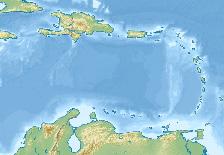
The Bahamas
Barbados
Belize
Cuba
Dominica
Dominican Republic
Grenada
Guyana
CONTENTS
Director’s Desk: Post-COVID-19 economic aspects of digital transformation
Digital transformation as a coping strategy to deal with the fallout from the pandemic in the Caribbean Post-COVID-19 Inflation in the Caribbean
The case for economic restructuring post-COVID-19 in the Caribbean
Fostering export diversification and structural change in the Caribbean
Regular Features
Recent and upcoming meetings
List of Recent ECLAC Documents and Publications
Haiti Jamaica
Saint Kitts and Nevis
Saint Lucia Saint Vincent and the Grenadines Suriname
Trinidad and Tobago
ASSOCIATE MEMBERS
Anguilla Aruba
Bermuda
British Virgin Islands Cayman Islands Curaçao Guadeloupe Martinique Montserrat Puerto Rico Sint Maarten
Turks and Caicos Islands
United States Virgin Islands
FOCUS: ECLAC in the Caribbean is a publication of the Economic Commission for Latin America and the Caribbean (ECLAC) subregional headquarters for the Caribbean/Caribbean Development and Cooperation Committee (CDCC).
EDITORIAL TEAM:
Director
Editor
Copy Editor
Diane Quarless, ECLAC
Johann Brathwaite, ECLAC
Denise Balgobin, ECLAC
Coordinator Sheldon McLean, ECLAC Proof Reader Veera Deokiesingh-Fraser, ECLAC Design and Layout
Produced by ECLAC
CONTACT INFORMATION
Liseanne Martin-Subero, ECLAC
ECLAC Subregional Headquarters for the Caribbean PO Box 1113, Port of Spain, Trinidad and Tobago Tel: (868) 224-8000 E-mail: spou-pos@eclac.org Website: www.eclac.org/portofspain
ABOUT ECLAC/CDCC
3 4 6 8 10 14
14
POST-COVID-19 ECONOMIC ASPECTS OF DIGITAL TRANSFORMATION

The economies of the subregion were hard hit by the COVID-19 pandemic, particularly those dependent on travel and tourism. The decisions now to be made by policy makers will determine if the countries are able to achieve the SDGs by 2030. They must decide whether to choose the business-as-usual path, or the path of structural transformation of their economies and societies.
In the last two years, we’ve learnt that continued ‘business-as-usual’ is no longer an option for advancing sustainable development in the subregion. Therefore, recovery and repositioning must take place at all levels, encompassing all sectors, if the subregion is to thrive.
One of the leading problems facing not just the subregion, but the world at large, is soaring inflation, and in particular, food prices. The International Monetary Fund (IMF) projects inflation for 2022 to be 5.7 per cent in advanced economies and 8.7 per cent in emerging and developing economies.
This FOCUS explores the role that digital transformation can play in repositioning our economies post-COVID-19; the use of digital technologies and processes to enhance the productivity and service quality of traditional sectors, such as agriculture, agro-processing and manufacturing; and the socio-political aspects of digital transformation. We also examine the effects inflation has had on the Caribbean in the post-COVID-19 era; the trends observed, scenarios that have caused it to rise, and the future prospects for the Caribbean, given the current economic climate.

A case for economic restructuring of our economies is also made; why it is necessary to sustain competitiveness, the challenges of diversification within the subregion and the institutions that can support industrial restructuring. Finally, this issue delves into strategies that can be used to help foster export diversification within the Caribbean, by focusing on how to build competitive export structures and move towards economic recovery.

FOCUS | 3 Issue 2 / April - June 2022
DIRECTOR’S DESK:
To deal with the hike in food, energy and fertilizer prices and disruption of supply chains from the war in Ukraine, policy makers will need to deploy strategies to access alternative supplies, manage food stocks and to provide temporary assistance for the most vulnerable.
Both the pandemic and the war have highlighted the need for policies to support changes in economic structures in the areas of work, production and trade, to allow for global competitiveness. Digital transformation, and even disruption in key areas, can help the subregion make the transition in greater productivity, efficiency and competitiveness. Digital transformation entails the strategies, processes and concrete actions to transform an economy and society from an “industrial age characterized by analogue technologies, to an age of knowledge and creativity characterized by digital technologies and digital business innovation” (Francione, 2022).
This article examines some key strategies and practical actions that Caribbean countries can take to accelerate digital transformation. The focus is on those areas that could help in repositioning the regional economy and society to compete globally.
I. ECONOMIC FOUNDATIONS: DIGITAL TRANSFORMATION FOR ECONOMIC REPOSITIONING
POST-COVID-19.
The pandemic has made ‘business as usual’ approaches to development obsolete (McKinsey Global, 2022). Revamped policy strategies and projects
DIGITAL TRANSFORMATION AS A COPING STRATEGY TO DEAL WITH THE FALLOUT

FROM THE PANDEMIC IN THE CARIBBEAN
Michael Hendrickson*
Caribbean economies have been disrupted by the pandemic and the fallout from the war in Ukraine. Therefore, in the short to medium-term, there is need for policies to deal with post-pandemic recovery, including strengthened health and safety protocols, social protection measures and managed economic reopening to stimulate growth and employment.
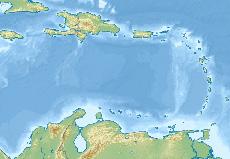
after the pandemic should focus on driving sustainable and equitable growth, as a basis for creating decent jobs in an environmentally sustainable manner. This is no easy feat for economies that have been battered by a decline in real output, job losses and a spike in public debt, owing to the pandemic. Therefore, digital transformation as a key adjustment strategy must be informed by a sound vision of what sectors, activities and projects have the highest benefit-cost ratios for the subregion.
Digital transformation of Caribbean economies entails two processes: the production of new digital products and services, particularly for export; and the use of digital technologies and processes to revitalize and transform traditional sectors, such as tourism, agriculture and light manufacturing. Given the critical role of digital disruption in the competitiveness of economies, it is essential that countries undertake a scoping exercise to determine which new digital services might provide the greatest competitive advantage for the subregion.
The first economic component of digital transformation is the use of digital technologies and processes to enhance the productivity and service quality of traditional sectors. Digitalized value chains are radically reshaping tourism and other traditional productive sectors, such as agriculture, manufacturing, education and public services, among others. In the mainstay tourism sector, the pandemic has accelerated the use of digital platform technologies, including contactless bookings, improved use of big data and data analytics to evaluate pandemic-induced changes in visitor
preferences for destinations and activities. This has been called ‘forced digitalization’ by Nick Hall, CEO of Digital Tourism Think Tank (Digital Tourism Think Tank, 2021). However, digitalization must now become the norm in the Caribbean tourism industry, by a vision that views these changes not as an add-on, but a fundamental pillar of their competitive strategy.
The Caribbean Tourism Organization has developed a ‘Digital Tourism Toolkit’, that provides a roadmap for tourism businesses and governments to optimize the use of digital platforms. The Toolkit focuses on increasing the number and spending of tourists, through a strong and credible digital presence and improving the guest experience, by increasing the number of outdoor activities that allow social distancing. The Toolkit promotes investment in technologies that are expected to become the norm in tourism, including guest message networks and platforms, online staff communication tools, contactless booking and payments and online ordering of food and beverages.
Nevertheless, as the subregion mainstreams artificial intelligence, big data analytics, machine learning and other frontier digital technologies in tourism and other activities, it is essential to focus on retraining and upskilling the workforce to prevent automation from significantly reducing the demand for labour. The Internet of Things (IoT) refers to “the interconnection of physical devices, vehicles, machines, buildings and other items with computers and other devices over the internet” (Hyseni, 2022). The IoT can assist in improving the efficiency of service delivery in many
4 | FOCUS
sectors in the Caribbean. In tourism it can facilitate smart luggage tracking to reduce lost luggage and mobile keys are already used to inform guests at hotels when their rooms are ready (CANTO, 2017). In the music industry the IoT can be used to facilitate remote collaboration, that allows producers to record bands in different studios (Pathak, 2020).
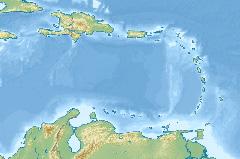
The subregion also needs to better leverage digital technologies and processes to upgrade its agriculture and agro-processing sectors (FAO, 2021). Digital agriculture provides a path to solving problems in agriculture, including productivity assessment and management, optimal use of inputs such as water and fertilizers by the use of smart sensors. These processes are supported by big data analysis, climatesmart solutions, such as the use of geographic information systems (GIS) to map hazard prone areas, and research and development for drought-resistant varieties of crops (UNECLAC, 2021). Vital technologies such as Cloud GIS and digital early warning systems could help to reduce disaster risk in agriculture and other sectors.
Globally, manufacturing has long been the forerunner in adopting new technologies. However, due to financial, human capital and technology constraints, Caribbean manufacturing has not often been proactive in adopting new, productivityenhancing technologies. The pandemic should be a wake-up call for the subregion’s manufacturers. In addition, producers now have the opportunity to make calculated investments in digital supply chain management to reduce the time to delivery of inputs, industry 4.0 platforms, including flexible industrial control systems, personalized and customized products and the use of artificial intelligence to cut marketing and advertising costs (I-Scoop.Eu, 2022).
The second major driver of digital transformation in the Caribbean is the provision of digital products and services. These could provide a path for the Caribbean to optimize investment and catalyze knowledge-based production and trade. According to the WTO (2022), year-on-year growth in services was 25 per cent in the third quarter of 2021,
despite the effects of the pandemic. This growth was mainly driven by digital services. The subregion needs to invest in areas, such as digital designs, that could enhance its cultural products and services. Also, e-commerce is ripe for increased investment, but this requires improved payment platforms, data protection and cybersecurity systems to boost confidence of businesses and consumers (Ram, 2021).
II. SOCIO-POLITICAL ASPECTS OF DIGITAL TRANSFORMATION
Alongside the economic approaches, key socio-political problems can be addressed by digitalization. The pandemic was a major driver of the use of digital platforms to provide learning for children in the subregion. However, this trend exposed the existence of significant inequality, as poorer households without adequate access to broadband internet, computers or mobile devices, were inadequately served. The postpandemic period offers an opportunity to mainstream the best aspects of digital learning into the subregion’s education system. For example, online classes should continue to be used to improve the skills of students who are challenged in key Science, Technology, Engineering, Arts and Math (STEAM) training areas, which are critical for their ability to function in a knowledge economy.
E-government has not progressed well in the Caribbean, owing to inadequate legislation, policies and back-tracking with changes of governments. The subregion now has an opportunity to mainstream e-government as a core aspect of its governmental operations to improve service efficiency and reduce costs.
CONCLUSION
The pandemic has led to a forced digitalization in the Caribbean as in some other regions. However, all indications suggest that there is no return to business as usual. Therefore, the subregion has a limited window of opportunity to make the necessary investments in technology,
human capital, systems and institutions to reap the benefits of the digital revolution. Digital transformation should not be seen only as a cost, but as a vital public good with a high rate of return. Innovative technologies such as the internet of things and machine learning provide opportunities for boosting efficiency gains in tourism, the music industry and other sectors. At the same time, there is also a need to search for new niches in key digital products and services such as digital designs, customized data solutions, digital cultural products and disaster solutions, that could advance the subregion’s development.
REFERENCES
CANTO, (2017), “Internet of Things in the Caribbean”, Caribbean Focus.
Digital Tourism Think Tank, (2021), “Digitalization in times of COVID”, DTTT Blog.
FAO (2021), “Caribbean countries seek to use climate-smart technologies to revolutionize regional agri-food systems”, FAO.
Francione, Carola (2022), “Digitalization”, Logosnet.
Hyseni, Vlere (2022), “How the Internet of Things Impacts Digital Transformation”, PECB.
Iscoop. Eu (2022), “Industry 4.0 and the fourth industrial revolution explained”. Mckinsey Global (2022), “COVID-19: Implications for Business Pathak, Ritesh (2020), “IoT in the Music Industry”, Analytic Steps.
Ram (2021), “Digital Transformation in the Eastern Caribbean”, Justin Ram Advisory. The Caribbean Tourism Organization (2021), “Digital Tourism Toolkit”, https://www. onecaribbean.org/resources/digital-tourismtoolkit/
UNECLAC (2021), “Digital Technologies for a New Future”.
WTO. (2022), “Will Digital Services Remain in the Vanguard of the Global Trade Recovery?”.
FOCUS | 5 Issue 2 / April - June 2022
The COVID-19 pandemic was an economic shock in 2020 that led to a significant fall in aggregate demand around the world, as countries implemented different strategies (including the closure of borders) to slow the spread of the disease. The following year saw economies begin to reopen as restrictions were lifted, following widespread distribution of COVID-19 vaccines, and a reduction in mortality rates
Tdemand resulted in consumption increasing rapidly. Pandemicrelated restrictions in sections of the supply chains around the world prevented supply from increasing to match demand. These two factors combined to push prices upward in 2021 and 2022. While initially expected to be transitory, the increase in inflation is now expected to last longer. The IMF projects inflation for 2022 to be 5.7 per cent in advanced economies and 8.7 per cent in emerging and developing economies. High inflation is affecting regions around the world and the Caribbean is no different. Rapid increases in prices will directly and indirectly serve to reduce social welfare, particularly among vulnerable groups. This article looks at the recent inflation trends in the Caribbean, discusses some of the reasons for the increase in prices, and concludes with some of the indirect consequences.
CARIBBEAN TRENDS

While different countries in the Caribbean have seen periods of high inflation at different points in their history, inflation has been quite low for several years. Average inflation¹ in the Caribbean (excluding Suriname2) has been below 2 per cent since 2018. In 2020, inflation fell below 0 per cent in several countries for a few months as the reduction in economic activity and lower fuel prices contributed to a fall in prices across the subregion.
Several economies, particularly in the eastern Caribbean, experienced deflation for most of 2020. In 2021 average inflation grew from 1.2 per cent in January to 3.6 per cent by the end of the year (see figure 1), coinciding with an increase in economic activity as the economies slowly reopened. In Guyana and Jamaica, inflation was greater than 5 per cent for most months in the year. The increase in prices has continued into 2022, with inflation in Jamaica reaching 11.3 per cent in March.
FACTORS
The reason for rising prices in the Caribbean is linked to a series of international factors. One of the main factors is international supply chain constraints. Many consumer goods are manufactured using complex

1 Inflation is defined as the year-on-year percentage change in the consumer price index, calculated monthly.
2 Suriname is unique among Caribbean countries as it has been experiencing very high inflation since early 2020.
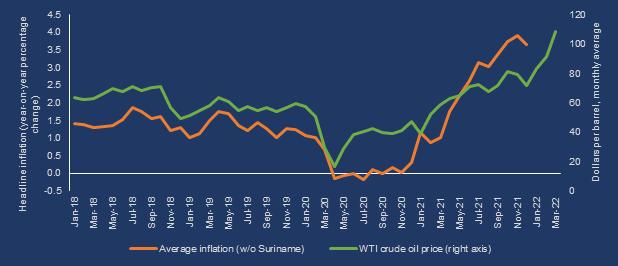
international supply chains, in which various intermediate goods necessary for production and sections of the manufacturing process are located in different parts of the world.
With the sharp fall in demand in 2020, many firms reduced their supply orders accordingly. However, stimulus programmes and shifts in spending to goods from services, facilitated by widespread adoption of online shopping, led to a sharp increase in demand in 2021; this caused a reduction in inventories, that led to a demand-supply imbalance. In addition, COVID-19 outbreaks in several manufacturing hubs such as Vietnam, led to reduced production and supply of manufactured goods in 2021. Due to the delays in shipping, some firms then chose to keep more inventory, which increased their costs. This, together
6 | FOCUS POST-COVID-19
IN THE CARIBBEAN
INFLATION
Machel Pantin *
Figure 1: Caribbean inflation and crude oil prices, Jan 2018-Mar 2022
Source: Economic Commission for Latin America and the Caribbean, on the basis of official figures; U.S. Energy Information Administration.
with other pandemic-related factors such as restrictions at ports, reductions in shipping containers (see figure 2) and shortages of workers, all combined to push up prices.
New factors appeared in 2022, including severe lockdowns in China and an acceleration of the Russia-Ukraine war. In China, an unprecedented surge in COVID-19 cases led to severe lockdowns in several cities in March. This resulted in a reduced volume of manufacturing output out of China, and while this has led to inflation in manufactured products, it also resulted in dips in the oil price and shipping costs out of China.
In February 2022, Russia invaded Ukraine and began a protracted military conflict which has caused direct and indirect supply disruptions. The conflict between these two countries, who together account for 29 per cent of the world’s wheat exports, has disrupted global grain supply. The food supply issue is compounded by a reduction in natural gas exports from Russia, which is used in fertilizer production. Many countries have applied various sanctions on Russia, including cutting imports of oil. It has been estimated that approximately 3 per cent of world petroleum production has been removed from the market (Lutz and Plante 2022). The monthly average price for West Texas Intermediate3 crude oil grew by 177 per cent from January 2021 to March 2022 (see figure 1).
PROSPECTS FOR THE CARIBBEAN

Increases in prices has resulted in monetary policy responses across the subregion. For example, the Bank of Jamaica (BoJ), which has an inflationtarget of between 4-6%, increased its policy interest rate by one percentage point to 1.5 per cent in October 2021. The BoJ has since raised the policy rate by 50 basis points (0.5 per cent) in November and December 2021 as well as February and March 2022, where it stood at 4.5 per cent.
Policy decisions in the North Atlantic will impact the decisions of the monetary authorities in the Caribbean. Rising rates in developed countries could see investments flowing away from developing countries. Caribbean countries could potentially increase interest rates this year, to limit this effect. Rising interest rates have a dampening effect on investment, and as such could lower growth prospects.
Rising prices also lead to fiscal policy adjustments. The governments of Barbados and Guyana both lowered taxes on fuels and reduced customs duties on freight to pre-pandemic shipping container levels. Other measures that governments might take include targeted transfers to vulnerable groups. Medium term responses include developing domestic substitutes, especially through food production. International food prices are particularly impactful to inflation in the Caribbean, which already had an expansive food import bill. The reduction in the global food supply caused by the Russia-Ukraine conflict and weather-related events among other food producers, will see food prices increase further in 2022. Rising food prices affect everyone, but more so those on the lower rungs of the economic ladder who spend a greater share of their income on food.
One of the major impacts of this current inflationary cycle would be rising costs of debt. Rising domestic and international interest rates result in increased interest
costs; this is happening at a time when Caribbean debt levels have increased significantly in the last two years due to increased expenditure in response to the pandemic. Total debt service payments grew from an average 28 per cent of government revenue in 2019 to 36 per cent in 2020. In addition, the end of Debt Service Suspension Initiative (DSSI)4 , which expired at the end of December 2021, will lead to an increase in debt service for the participating Caribbean economies5 .
Given the current projection for an extended period of rising international prices, Caribbean policy makers will face yet another headwind to their goal of sustainable economic growth, even as they continue to recover from the COVID-19 crisis of the past two years.
SOURCES
Freightos Baltic Index, available at https://fbx. freightos.com.

IMF (International Monetary Fund). 2022. World Economic Outlook, April 2022, Washington D.C. Kilian, Lutz and Michael D. Plante. 2022. The Russian Oil Supply Shock of 2022. Federal Reserve Bank of Dallas, March 22, 2022. Available at https://www.dallasfed.org/research/ economics/2022/0322
The Economist. 2022. The coming food catastrophe. Available at https://www.economist. com/leaders/2022/05/19/the-coming-foodcatastrophe U.S. Energy Information Administration. Crude Oil Prices: West Texas Intermediate (WTI)Cushing, Oklahoma [DCOILWTICO], retrieved June 2, 2022, from FRED, Federal Reserve Bank of St. Louis; https://fred.stlouisfed.org/series/ DCOILWTICO.
3 One of the three main price benchmarks
4 The DSSI was set initiated by the Work Bank, IMF and G20 to suspend debt service from vulnerable nations during the pandemic.
5 Dominica, Grenada, Saint Lucia, Saint Vincent and the Grenadines.
FOCUS | 7
Issue 2 / April - June 2022
Figure 2: Global Container Index, Dec 2017 – Mar 2022 (US$ per 40-foot container)
Source: Freightos Baltic Index, available at https://fbx.freightos.com.
This article outlines some strategies to advance economic restructuring, which is now urgent in light of the economic and social effects from the COVID-19 pandemic, and food inflation aggravated by the war in Ukraine.
WHAT IS ECONOMIC RESTRUCTURING AND WHY IS IT NECESSARY?

The term economic restructuring connotes different things to different persons, but from an economic point of view, it has a distinct meaning. It refers to an increase in the share of domestic value added in existing products and activities, an increase in the number of sectors and activities contributing to overall output and productivity, and a strengthening of intersectoral linkages. Restructuring relates not just to the economy, though much of the emphasis is often placed there.
Changes in the economic landscape also imply reforms in the social and institutional architecture. This implies opening the economic space for new actors in business, setting rules that are clear and transparent, and as a corollary, increasing participation of all groups in sustainable development, including youth and women. This latter concern is very apt for small States where income inequality can be high, and many are left behind. In light of the COVID-19 pandemic and its aftershock, structural change is necessary at several levels. For example, most Caribbean economies rely
THE CASE FOR ECONOMIC RESTRUCTURING POST-COVID-19 IN THE CARIBBEAN
 Dillon Alleyne*
Dillon Alleyne*
Since the global crisis of 2008-2009, there has been less confidence in the primacy of markets to lead sustainable development among developing countries in general and small island developing States (SIDS) in particular. It is acknowledged that markets need discipline and an institutional context that can support private gains while reducing social costs and delivering less inequality. Prompted by declining competitiveness in leading sectors, and a commitment to addressing the United Nations Sustainable Development Goals (SDGs), governments in the subregion have been developing long-term plans aimed at economic change.
on a single good or service for the bulk of their foreign exchange earnings, and this exposes them to negative external shocks when these sectors decline. In addition, the post-COVID-19 world will be characterized by increased interconnection, digitization and greater use of artificial intelligence in all processes.1 Restructuring is necessary to sustain competitiveness in this changing environment. On the social front, the fallout from COVID-19 has demonstrated that the social security
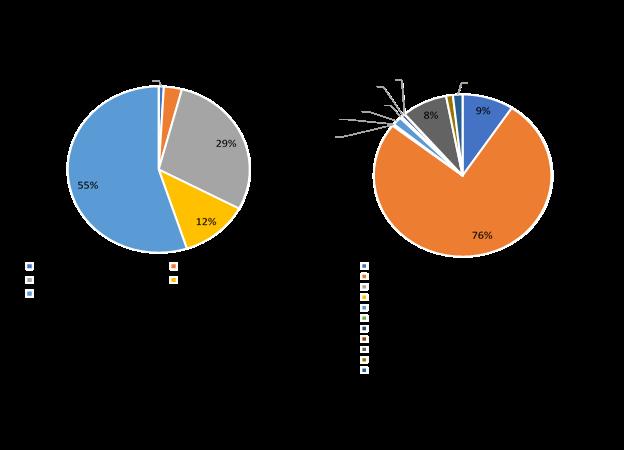
systems in the subregion are inadequate to address the needs of the most vulnerable. In addition, the current delivery of education and health are not robust enough to withstand such shocks. One of the lessons learnt from COVID-19, is that these social challenges have feedback effects on the economic system and as a result business as usual is untenable.
1 Manyika et al (2013) refer to the coming technological changes as disruptive technologies and suggest that these are the technologies that matter. They identify among others, mobile internet, automation of knowledge work, the internet of things, cloud technology, advanced robotics, autonomous and near autonomous vehicles, next generation genomics, energy storage, 3D printing and renewable energy. Two areas are of considerable importance. Advance robotics will reduce the demand for a variety of service jobs and advances in renewable energy technologies will create efficiency for small states with these abundant resources
8 | FOCUS
Technology Intensity of Exports for 2017 and Composition of Service Exports for 2015.
DIVERSIFICATION SETBACKS AND WHAT IS REQUIRED.
As was pointed out above, economic restructuring is more than economic change. However, a key element in such change is economic diversification.2 In some countries, it means moving away from a narrow range of services (mostly mass tourism) and in others, it is reducing the reliance on natural resources such as hydrocarbons, primary agriculture, gold or bauxite production for foreign exchange earnings. In many countries, over time, there have been attempts at diversification and although in some cases there have been some success3, the subregion remains largely reliant on primary production at the low end of the value-added spectrum.
Successful restructuring requires an industrial policy aimed at achieving greater competitiveness through increased productivity, greater intersectoral linkages and more access to decent jobs. Modern systems of production have changed significantly with the emergence of global value chains, the elevation of niche markets and the use of knowledge, information and innovation in all processes. Thus, underpinning any strategy for diversification in a Caribbean context must be investment in the domestic capitalmaking sector, and the utilization of capital services4 for global exports. Diversification thus must take these economies in the direction of knowledge economies, while increasing their export capacity (Alleyne 2019). This immediately suggests not just reducing the cost of doing business (Brenton et al. 2009), but also raising the quality of the labour force through the development of real skills by way of both the formal and informal educational system.
Apart from the traditional school system which does not cater to a broad range of intelligences, there must be world class vocational training so that the youth have a menu of high-quality offerings to choose from. Given the high rate of youth
unemployment, and limited entrepreneurial activity among youth and women, both of which fuel emigration among the best and brightest of the youth in the Caribbean (Alleyne and Solan 2019), much can be done in this area. Given the considerable sums spent on education in the subregion, the challenge is not more schooling but getting value for money (World Bank and UNICEF 2021, IDB 2015, Jules 2014).
At the core of restructuring, buttressed by an industrial policy, must be the development of a national system of innovation that is linked to the productive system, with joint participation in training by both the private and public sectors. Finally, there must be consistent investment in science, technology and innovation, and a removal of constraints on the creative industries and sectors.
WHO GAINS AND WHO LOSES
Industrial restructuring is good for growth - it is good for improving the social sector and should allow for greater participation of all in sustainable development. However, it will not simply be wished into being simply because it is desirable. Governments must take the lead in crafting industrial policies that calibrate new activities, with the requisite skills needed, and the institutional and financial support necessary for success.
The recent commitments to long-term plans and to investing in the critical SDGs is a necessary start, but this is not sufficient. Modern industrial policy covers a range of areas such as competitiveness policies, trade and inward foreign direct investment (FDI) policies, innovation, human resource training, upgrading the tourism sector, and single market economy (SME) development to name a few. The aim is to focus on those activities that have positive spillovers to additional sectors and activities (Stiglitz 1999).
It has often been suggested by opponents of industrial policy, that good industrial
policy is - no industrial policy - on the assumption that governments are inefficient, and they create opportunities for rent seeking. The case made by Mariana Mazzucato (2011) however, is that the role of the government, in the most successful economies, has gone way beyond creating the right infrastructure and setting the rules. It is a leading agent in achieving the type of innovative breakthroughs that allow companies, and economies to grow, and not just by creating the ‘conditions’ that enable innovation.
While it cannot be denied that governments are often inefficient, industrial policy must aim to remove the constraints to service and activity expansion, including improving logistics and trade facilitation. Getting an expanded private sector on board is necessary and the system of innovation must also connect innovators with investors. There are a few firms in the Caribbean that are world class, but these do not represent the average performers, as overall productivity is low and informal business activity is high. Industrial policy must facilitate a reduction in informality and an increase in the number of firms that can provide global export services.
2 There is vertical diversification relating to firms moving up or down the value chain and horizontal which refers to including new activities and processes.
3 The “domestic capital” cluster includes sectors such as education, healthcare, ICT, finance, engineering, architecture, and the creative industries, as well as the using industries such as tourism, travel services, wholesale and retail (James August 2018. Best and The Engines of Caribbean Growth and Development: Theory and Evidence, unpublished)
4 The “domestic capital” cluster includes sectors such as education, healthcare, ICT, finance, engineering, architecture, and the creative industries, as well as the using industries such as tourism, travel services, wholesale and retail (James August 2018. Best and The Engines of Caribbean Growth and Development: Theory and Evidence, unpublished)

FOCUS | 9 Issue 2 / April - June 2022
on page 12)
(continued
To achieve these, the subregion must build the requisite economic resilience, among other things, and these must be buttressed by regional integration drivers and various forms of cooperation.
REGIONAL INTEGRATION, STRUCTURAL CHANGE AND EXPORT DIVERSIFICATION
After six decades of regional integration, the subregion continues to specialize in relatively low value-added segments of global value chains, including various forms of tourism and natural resource exports. Trade competitiveness and

FOSTERING EXPORT DIVERSIFICATION AND STRUCTURAL CHANGE IN THE CARIBBEAN

As part of the repositioning of the economies of the subregion, economic diversification, and structural change are vital.
productivity have been on the decline, while high levels of unemployment have been a persistent challenge. In addition, the subregion’s food and merchandise imports remain high, with potential areas of comparative advantage remaining underexplored. Furthermore, the benefits of the Caribbean Community (CARICOM) single market and economy (CSME), have been distributed asymmetrically, as the stronger manufacturing economies tend to dominate intra-regional commerce.
A closer look at the data reveals that the merchandise exports of CARICOM is highly concentrated, with the top 10
products accounting for 74 per cent of exports (value) over the period 2010-2020, and 91 per cent of global exports in 2020 alone. In addition, the subregion’s range of manufactured products is extremely narrow, with natural resource-based manufactures dominating exports, accounting for 48 per cent of CARICOM’s exports. Medium-low technology manufactures, in turn, account for 30 per cent while high technology manufactures account for only 2 per cent of the subregion.
At the global level, CARICOM’s total exports represent only 0.09 per cent of the world’s total export, making it a very

10 | FOCUS
Sheldon McLean *
Table 1: CARICOM Export Share to the World (SITC Single Digit) (Percentage of world exports)
Source: United Nations conference on Trade and Development (UNCTAD)
small player in world trade. Even the exports of various product groups such as food and live animals, beverages and tobacco, and crude materials are all less than 1 per cent of the world’s exports (table 1).
The implication is that substantial technical, development, and financial support may be necessary to push the subregion up the value chain. In addition, there has not been substantial structural change and export diversification over time.
BUILDING COMPETITIVE EXPORT STRUCTURES
In 1997, the World Trade Organization (WTO) ruled that the European Union (EU) banana import regime was inconsistent with WTO rules. In 2005, the WTO also ruled that the EU subsidized sugar exports beyond the levels agreed in the Uruguay Round of world trade negotiations and, as a consequence, reform of the EU sugar regime should be implemented. As part of that reform, in 2007, the EU denounced the African Caribbean Pacific (ACP) EU Sugar Protocol, providing for the termination of ACP preferences by October 2009. Following those rulings, the EU commenced enforced reform programmes which led to the dismantling of longstanding preferences.
The EU, the US and Canada also began increasingly to negotiate a series of bilateral and plurilateral free trade agreements. Collectively these actions eroded the subregion’s margins of preference, which invariably led to its further uncompetitive positioning in comparison to many emerging economies that exhibited significant production scale and abundance of
domestic capital inputs.

The subregion also has not succeeded in the integration of production based on cross-border specialization, facilitation of unrestricted movement of financial capital, labour, technology, and the creation of a de facto integrated and liberalized internal market, as articulated in the Revised Treaty of Chaguaramas1 .
It is important, therefore, to unearth credible comparative-advantage-based avenues for export diversification supported by the fostering of backward and forward linkages, that would allow subregional goods and services production to move from the periphery of the production frontier, while shifting away from an overreliance on imported inputs (capital)2 and focusing on optimizing capital services exports.
Table 2 displays CARICOM services exports as a share of the world services exports. The data suggest that for each services category, the subregion’s share is less than 1 per cent of the world services exports. Therefore, CARICOM is a relatively small services exporter with the potential to diversify and expand its services offerings.
This notwithstanding, the Caribbean’s global services trade has steadily trended upwards since 2005. The subregion’s services exports growth expanded from just under US $10 billion in 2005 to over US $16 billion in 2019 (UNCTAD). However, using the TradeCAN methodology developed by ECLAC to assess trade competitiveness, it was revealed that few service categories are truly competitive. Over the decade of 2009 to 2019, only one service category, cultural and recreational services, was revealed to be a “rising star” i.e., having increased global market share in a dynamic (growing) market.
The subregion’s largest service sector, travel services, is categorized as a declining star, which is a sector that is gaining market share in a declining market. Several key tertiary service sectors are “missed opportunities”, meaning these are sectors losing market share in a growing market.
1 This has in no small way underpinned its declining trade complementarity with its major trading partners (with the exception of Asia) and countries with which it has trade agreements. This was demonstrated through ECLAC’s analysis using the Trade Complementarity Index (TCI). Further, examination of the Grubel-Lloyd Index has also revealed that the Caribbean’s manufactures exports are largely inter-industry in nature, with insignificant levels of intra-industry, intra-regional or extra-regional commerce.
2 This is particularly important for the tourism-based economies which saw their economies contract by as much as 25 per cent (in the case of Saint Lucia) in 2020 as global economies instituted measures to slow the spread of COVID-19, which essentially shut down the tourism sector during the second quarter.

FOCUS | 11 Issue 2 / April - June 2022
on page 13)
(continued
Table 2: CARICOM Services Exports (Percentage of world service exports)
Source: United Nations conference on Trade and Development (UNCTAD)
THE CASE FOR
ECONOMIC RESTRUCTURING
POST-COVID-19 IN THE CARIBBEAN (CONTINUED)
SUPPORTING INSTITUTIONS
Industrial restructuring designed to move the economies of the subregion from low to high growth activities and raising incomes and productivity, implies institutional change as well. Policies that protect one sector versus another will fail. The tools of industrial policy must be transparent, and governments must be prepared to accept failure and move on, because the only blueprint in this process is in learning by doing.
Those institutions that are a success must be scaled up and should be an example for others to follow. This implies engagement with a broad range of stakeholders, so that the costs and benefits of policies can be properly assessed and understood. For example, budgetary processes aimed at identifying government priorities must be transparent and accountable by receiving submissions from the communities, including those most affected by a particular policy.
Industrial restructuring also implies the need for adequate finance to support new sectors, new entrepreneurs, and new institutional forms. Given the binding fiscal constraints facing governments in the subregion, the private sector would have to be incentivized if this process is to be a success. This requires the use of innovative financing mechanisms that are effective and efficient at financing agreed priorities. A big leap forward is possible with the improvements in the environment for existing and new business. Also, investing in e-governance can go a long way in supporting this effort.
CONCLUSION
This article makes clear that business as usual will not make the Caribbean resilient in light of post COVID-19 expectations. It urges industrial restructuring to embrace a whole-ofsociety approach and suggests key elements in that process. This includes an industrial policy that creates new business opportunities and reduces the cost of doing business. Investing in e-governance is important to creating efficient governance structures. In addition, the role of innovation and the unleashing of domestic creativity is very necessary for the provision of global service exports.

However, this development, which is suggested, is not instant coffee and has to be a long-term project in which the governments, the society and the development partners, are focused on clear and manageable goals and activities that are subject to continual monitoring and evaluation.
REFERENCES
Alleyne, Dillon and Solan I (2019) Leveraging the Caribbean Diaspora for Development: The Role of Network Effects. Springer International Publishing AG, part of Springer Nature. International Publishing AG, part of Springer Nature 2019 M. Elo, I. Minto-Coy (eds.), Diaspora Networks in International Business.
Alleyne, Dillon. The New Caribbean: Building a Knowledge Based Society. Presented to the Research Annual Review Seminar, Central Bank of Trinidad and Tobago. June 27-28, 2019.
Brenton Paul; Newfarmer, R and Walkenhorst, peter.2009. (Commission on growth and Development). Avenues for Export Diversification: issues for low-income countries. MPRA at Paper no 22758.
IDB Caribbean Regional Quarterly Bulletin V4, Issue 2, July 2015.
Jules, Didicus (2014). Reshaping Caribbean Education. An urgent imperative. Presented to the CARICOM Heads of government. Manykiya, James, Michael Chui, Jacques Bughin, Richard Dobbs, Peter Bisson, Alex Marrset (May 2013). Disruptive technologies: Advances that will transform life, business, and the global economy. McKinsey Global Institute.
Mazzucato Mariana (2011). The entrepreneurial State. Demos. Available at https://www.demos.co.uk/files/ Entrepreneurial_State_-_web.pdf
Stiglitz, J. (1999) Public policy for the Knowledge economy. (1999). Department for Trade and Industry and Center for economic Policy Research London, U.K. January 27. World Bank and UNICEF (2021). Public Expenditure review Jamaica.
Pathak, Ritesh (2020), “IoT in the Music Industry”, Analytic Steps.
Ram (2021), “Digital Transformation in the Eastern Caribbean”, Justin Ram Advisory. The Caribbean Tourism Organization (2021), “Digital Tourism Toolkit”, https://www. onecaribbean.org/resources/digital-tourismtoolkit/
UNECLAC (2021), “Digital Technologies for a New Future”.
WTO. (2022), “Will Digital Services Remain in the Vanguard of the Global Trade Recovery?”.
12 | FOCUS (continued from page 8)
FOSTERING EXPORT DIVERSIFICATION AND STRUCTURAL CHANGE IN THE CARIBBEAN (CONTINUED)

Services sectors which can be key poles of industrialization and diversification drivers in the Caribbean include the creative industries; education, architecture, sports, health and medical tourism; community-based and ecotourism; business process and other tertiary services; renewable energy services; as well as information and communications technology (ICT), intellectual property and knowledgebased services. These represent areas for development cooperation and investment, with a focus on improving the macroeconomic landscape whilst also being part of the domestic capital making sector (James and Hamilton 2022). This should be geared towards not only optimizing the Caribbean service export trade but also providing a new dais of production integration and economic diversification.
In the category of goods, there are rising stars in machinery and transport, miscellaneous manufactures, and primary commodities. Alongside this, there are also missed opportunities in food and live animals, animal and vegetable oils, beverages and tobacco, chemicals and related products, and crude materials except fuel. There are no declining stars. There are also areas of goods exports that are uncompetitive such as some manufactured goods, and mineral fuels.
TOWARDS ECONOMIC RECOVERY
There is no panacea for the subregion’s trade-related challenges. However, what is important is the adoption of a regional approach to resilience building, particularly since the COVID-19 pandemic exposed the Caribbean’s vulnerability to
international supply-chain bottlenecks. Improving trade facilitation through simplifying border procedures, will help to reduce trade-related friction at the subregion’s ports of entry.
In addition, the subregion’s structural gaps which have constrained its industrialization and resiliencebuilding efforts, must be bridged by industrial policies that aim to increase international competitiveness through increased productivity, using improved technology, knowledge, workforce skills, greater intersectoral linkages and improved access to decent jobs.
Buttressed by regional integration drivers and improved mechanisms and policies conducive to integration, free trade, development in human resource, development of climateresilient measures, and development of technology and innovation which, when combined, will transform the subregion’s goods and services offering, the Caribbean economies would be armed with meaningful levers for economic recovery.
REFERENCES
James, August (2018), Best and The Engines of Caribbean Growth and Development: Theory and Evidence, Unpublished.
Vanus James and Rosalie Hamilton (2022). Strategic Factors In Economic Development Revisited. Tapia House Movement Maracas, St Joseph, Trinidad Managing Editor, Lloyd Taylor.
Trinidad and Tobago Ministry of Trade and Industry (2019), “Trinidad and Tobago Trade Policy 2019-2023: Towards Sustainable Economic Growth and Diversification.
Montobbio, Fabio, and Francesco Rampa
(2005), "The impact of technology and structural change on export performance in nine developing countries", World development 33 (4): 527-547 [online] https:// www.sciencedirect.com/science/article/pii/ S0305750X05000021
Sookram, Sandra, Hosein, Roger, Boodram, Leera and Saridakis, George (2022), Determining Factors of FDI Flows to Selected Caribbean Countries, Journal of Risk and Financial Management 15: 48.
FOCUS | 13 Issue 2 / April - June 2022 (continued from page 10)

14 | FOCUS List of Recent ECLAC Documents and Publications Listed by Symbol Number, Date and Title LC/TS.2021/209 February 2022 Synthesis of policy interventions responding to integrated water resources management challenges in the Caribbean LC/TS.2022/16 March 2022 A review of the status of institutional mechanisms for sustainable development planning in the Caribbean LC/CAR/TS.2022/2 May 2022 Preliminary overview of the economies of the Caribbean 2020–2021 APRIL 20 April 2022 Regional Realities - Challenges, priorities and actions for the post-COVID-19 recovery and realizing the SDGs Decade of Action 20 April 2022 National Consultation - Sustainable Recovery and Resilience towards achieving the Sustainable Development Goals JUNE 16 June 2022 Preparation for the High Level Political Forum RECENT AND UPCOMING MEETINGS 2022

FOCUS | 15 Issue 2 / April - June 2022
The Magazine of the Caribbean Development and Cooperation Committee ECLAC Subregional Headquarters for the Caribbean
PO Box 1113, Port of Spain, Trinidad and Tobago Tel: 868-224-8000 E-mail: eclac-spou-pos@eclac.org
vrb.al/eclaccaribbean
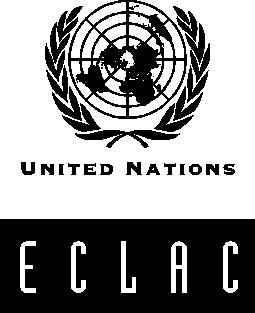
16 | FOCUS


















